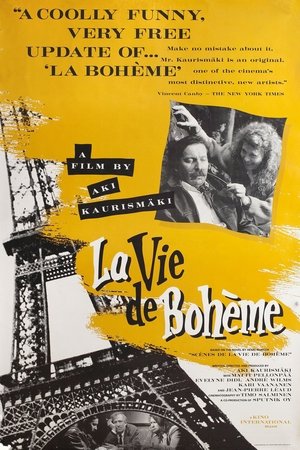
La Vie de Bohème
Aki Kaurismaki’s La Vie de Bohème is the Finnish auteur's loose adaptation of Henri Murger's classic 19th-century collection of short stories, set in contemporary Paris with an eclectic cast of French and Finnish actors, all speaking French. As the film opens, the penniless aspiring writer Marcel (André Wilms) is being evicted from his apartment. Though a series of amusing events, he falls in with the equally aspiring and penniless painter Rodolfo (Matti Pellonpää) and composer Schaunard (Kari Väänänen). The film then tracks their comical struggles to make money, gain lasting fame, or charm women in spite of their lack of a stable existence (Evelyne Didi plays a major supporting role as Rodolfo's girlfriend Mimi). Though the three men are perennially underdogs, their firm friendship and readiness to share what little they have makes the film a heartwarming experience. The poorly spoken French of the foreign actors, as well as the mismatch between the ostensibly 1992 setting and the decaying interiors, must have seemed bizarre for viewers who didn't know Kaurismäki before. However, it is quite of a piece with this director's prior work. Kaurismäki had made a number of films in his native Helsinki that are ostensibly set in the present day, but feature ramshackle tenements, working-class struggles, and antique appliances that are all right out of the 1950s. At some point, a band will appear on a stage playing high-energy rock music from a bygone age. In LA VIE DE BOHEME, Kaurismäki has reused the exact same elements in a Parisian context. He managed to find decrepit places one would have never expected in the modern city, and in one scene a punk band perform even if it has little relevance to the overall plot. While Rodolfo and Schaunard are explained as Albanian and Irish immigrants, respectively, they are really bringing to this film a typically Finnish quality. One of the quirks of Kaurismäki's Finnish-language output is that the actors deliver their deadpan, almost robotic lines in the Finnish literary language, which is vastly different from the ordinary Finnish spoken language. Kaurismäki has managed to create a similar effect here by lifting dialogue from Murger's original book, as in 19th-century stories the actors often speak with elaborate constructions and literary flair that is completely unrealistic for the particular setting. Their's also an amusing opposition between the garrulous Marcel and -- remember, the character's Irish or Albanian back stories need not be taken seriously -- the silent, stony other characters, as the Finns are an infamously taciturn race. Still, Kaurismäki's applications of his perennial formula are usually very entertaining, and I never tire of his dark humourly vision. And even if most of the other elements are the same as always, La Vie de Bohème features an unexpected ending. Usually in Kaurismäki you can foresee the nice little ending that's going to come from a mile away, but here he takes the viewer by surprise. Cinema aficionados will enjoy the small roles of a sugar baron, played by legendary French New Wave actor Jean-Paul Léaud, and a publishing magnate, played by American director Samuel Fuller. (Viewers who don't know who Fuller is will think it odd that he exits the stage with some profanity spoken in English and a distinctive old-timey New York Jewish accent!) This might not be the best introduction to Kaurismäki -- the films making up the so-called Proletariat Trilogy might work better for that. Still, for me La Vie de Bohème was a funny and touching picture.
